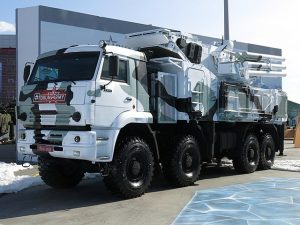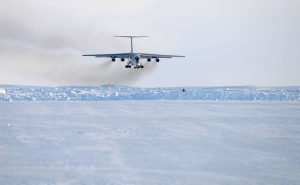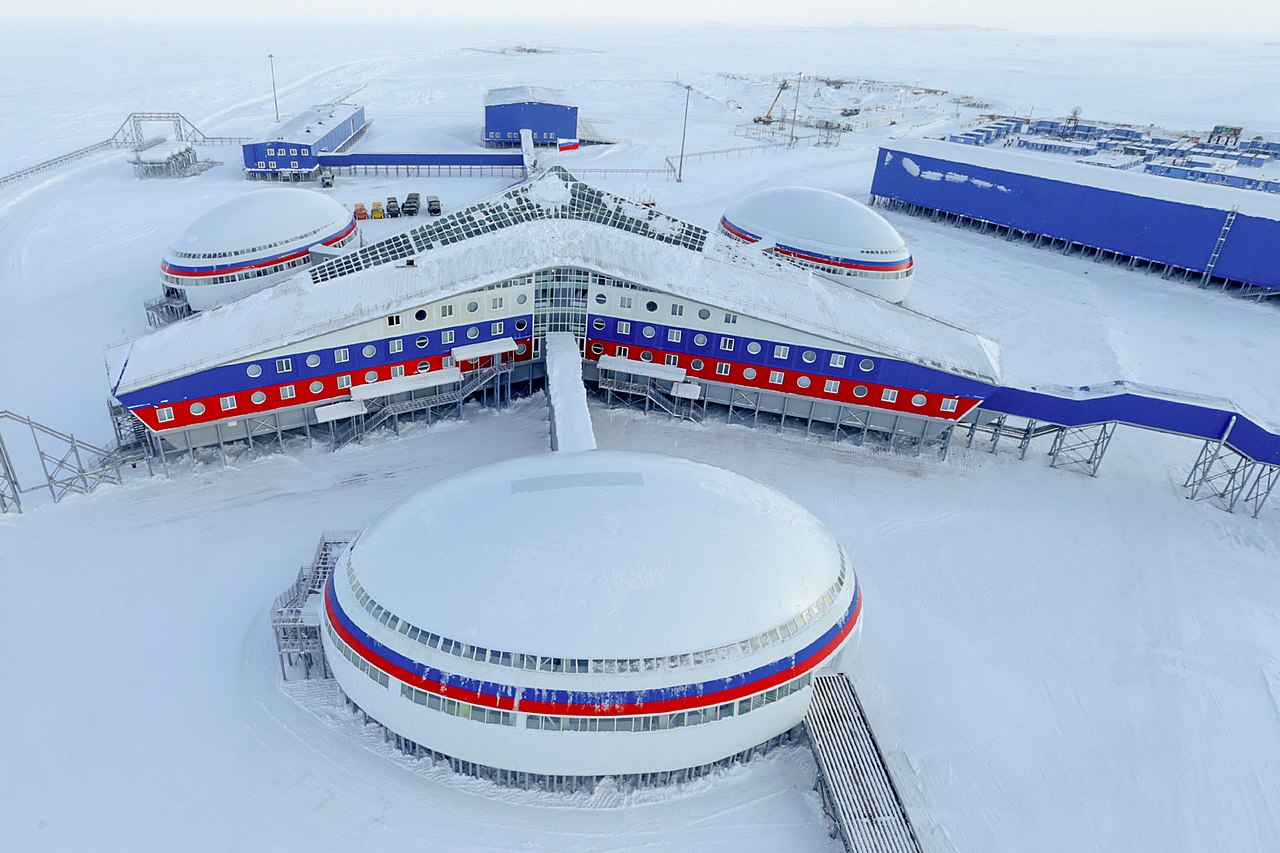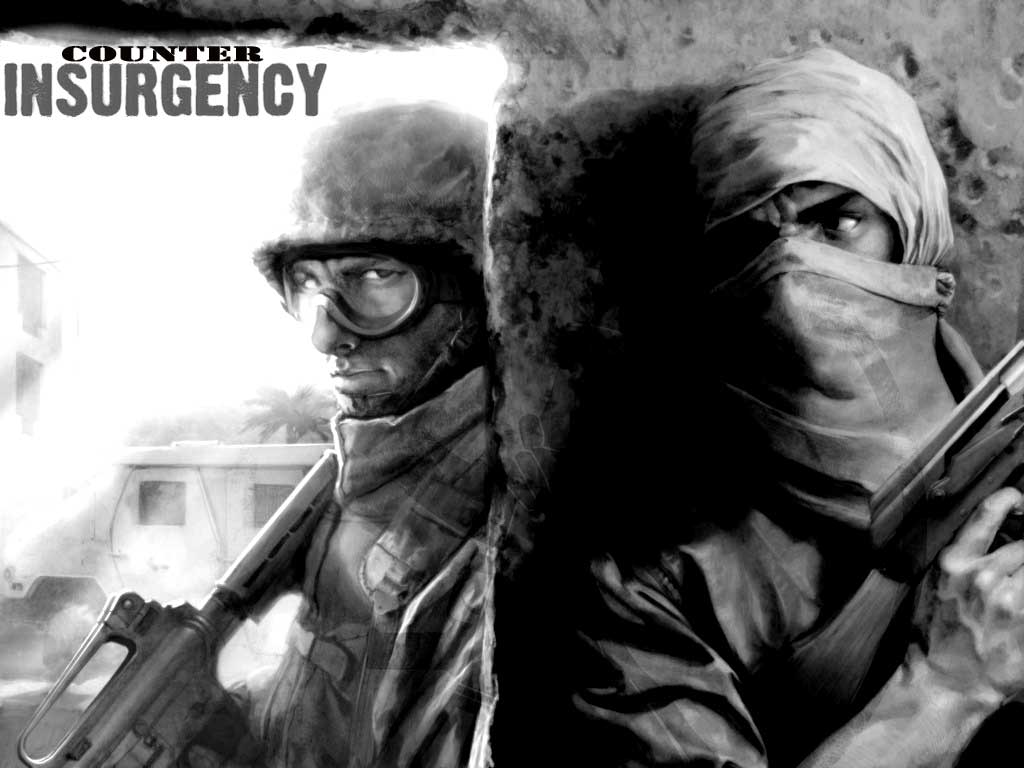The Arctic has become a new stage for a military competition between the East and the West. Russian expansion to the Arctic raises concerns throughout NATO and brings back the atmosphere of the Cold War, this time in a particularly cold setting. Russian military presence increases throughout the northern regions, as the ice sheet retreats and uncovers new frontier to be guarded and defended. The Arctic affairs have been long in the background of NATO politics, let alone military. But with Russian expansion, all eyes turn to the north, as there are concerns that NATO might be severely lacking in a military competition that is going on. Is this the reason Russian actions are perceived as threatening?
There is a lot of investment and interests across the Russian part of the Arctic that needs guarding, from maritime routes to oil and gas infrastructure, to military assets. The Russian military is building and reconstructing infrastructure of the most remote areas, such as Wrangel Island, Franz Josef Land or Novaya Zemlya. Increased military presence concerns NATO members (mainly the United States), who see these actions as a potential preparation for conflict. On the other hand, Russia feels the need to protect its assets from NATO, as its member states stretch may be too close to the Russian borders (Norway in the west, US state of Alaska in the east). NATO members also stepped up their Arctic game, with military exercises designed to bolster cooperation. Both sides seek to project the power in the region, while keeping the tensions at reasonable levels.
Russian expansion to the Arctic
Russia is making news headlines with their military spending in remote areas. There is a wide range of projects, but the main sectors are military bases and naval superiority, combined with aerial support infrastructure. There is only a limited landmass in the Arctic, so a strong navy and air force are a priority. The main force in the Russian territory of the Arctic Ocean is the Northern Fleet. Headquartered in the Severomorsk naval base near the city of Murmansk, it is the only fleet that forms its military district, The Northern Military District, since January 1, 2021 [1]. It is comprised of some of the most powerful machinery in the Russian armed forces, including nuclear-powered missile and torpedo submarines, aircraft carriers or antisubmarine aviation [2]. Being the main Russian fleet, it has the best available ships and submarines, such as the flagship aircraft carrier Admiral Kuznetsov, Kirov-class battlecruiser Pyotr Velikiy, and nuclear-powered submarines carrying ballistic missiles, including the Borei-class Knyaz Vladimir or the Akula-class Dmitry Donskoy, the largest active submarine in the world [3].

What raises concerns in the NATO ranks is the rebuilding and upgrading of the military bases scattered through the Arctic. Many of these bases were built during the Soviet era and served as a reminder of the Cold War. Russia is investing heavily into the development of remote sites, rebuilding airstrips and enlarging the compounds. Since there are many such bases, this article presents only the bases with significant presence and improvement, that means the bases on Wrangel Island, Kotelny Island, port of Tiksi, Novaya Zemlya, Alexandra Land and the Kola Peninsula.
Starting from the east, a new naval base was built on the Wrangel Island, located approximately 480 kilometres from the coast of Alaska, outfitted with a trefoil structure (three interconnected buildings designed for the harsh Arctic environment) and a Sopka-2 radar [5]. The radar has an effective range of 350 kilometres, allowing it to detect an aircraft in the Bering Strait, just outside the US territory [5]. In addition, the island contains the S-300 air defence system and Pantsir-S1 anti-aircraft system [6]. Considering the enormous length of the Russian northern coast Wrangel Island may seem remote and unimportant, but is quite the opposite. The Russian Arctic has a layered defence system containing all main Arctic islands.
Moving west, there is Kotelny Island, part of the New Siberian Islands archipelago. Similar to Wrangel Island, it contains a trefoil base (called the Northern Clover), an airbase capable of receiving Russian fighter aircraft and a Sopka-2 radar [7]. It also hosts a strong defence system, namely the Bastion-P mobile coastal defence missile system and the aforementioned Pantsir-S1 air defence system [7]. Kotelny Island is another settlement, from which the Northern Sea Route can be controlled, as the route itself passes between the New Siberian Islands and the Russian mainland coast.
On the coast of the Laptev Sea is the settlement of Tiksi. This port in the Republic of Sakha lies in a quite inhospitable, but strategically important region. The military use of Tiksi lies in its combination of naval and airbase. It is the main base of the 3rd division of anti-aircraft defence of the 45th Army of Air Force and Air Defence of the Northern Fleet [8]. Several statements were made by Russian Northern Fleet officials that Tiksi would receive an infrastructure for hosting MiG-31 aircraft and modern S-400 surface-to-air missile units, along with long-range strategic bombers, but a report from 2020 did not find any of this machinery in the satellite imagery [9]. Nevertheless, the satellite images still show increased military activity, indicating the development of the military base, based on the sightings of an increased number of helicopters and aircraft, including the giant Antonov An-22 transport aircraft [9].
The previous three sites were in the eastern part of the Arctic, where the military equipment is typically aimed towards detection and tracking. Western Arctic is the region where Russia deploys most of its military power in terms of offensive and defensive capabilities. The archipelago of Franz Josef Land, more precisely the Alexandra Land Island, is home to the northernmost military base in the world, complete with the typical trefoil structure and Nagurskoye air base [7]. This outpost is quite heavily armed, featuring the state-of-the-art S-400 surface-to-air missile system, considered one the best air-defence systems in the world [7]. In addition, it has got the capabilities to receive and host all kinds of aircraft, including Su-34 and MiG-31 fighter jets [10]. The position of this base is one of its important traits, as the Franz Josef Land archipelago is in the eastern Barents Sea, making it the perfect base for projecting power in the North Atlantic, especially the gaps between Iceland, Greenland, the British Isles and Norway. Potentially, it could enable disruption of the NATO force in the Atlantic and even reach the US Thule airbase in Greenland with combat aircraft refuelling mid-air [10]. This presents a significant security challenge for NATO, which is why it closely watched the Russian military exercises in the last few years, which will be mentioned later in this article.
The last island military base is on the Novaya Zemlya archipelago, which divides the Barents and the Kara Sea. Similar to Alexandra Land and the Nagurskoye airbase, Novaya Zemlya also received the S-400 missile system, as well as radar equipment and tools for electronic warfare [7]. In addition, the Rogachevo air base reportedly received a Quick Reaction Alert force, which means usually a fighter aircraft unit on patrol 24 hours a day, in this case, the MiG-31 fighter jets [11]. Novaya Zemlya functions as a pillar in the Russian system of bastion defence, because its radar and aircraft coverage connect other notional “circles” around other bases in the western Arctic, mainly on Alexandra Land and the Kola Peninsula.

Finally, the most important military area in the Russian Arctic is the Kola Peninsula. This is where Russia keeps most of their defensive and offensive capabilities. The Severomorsk base is the headquarters of the Northern Fleet and the peninsula is one large military complex with many navies and air bases and it is the main site for exercises (such as the aforementioned bastion defence) and weapon tests. The Gadzhiyevo submarine base hosts a fleet of nuclear ballistic missile submarines, the Severomorsk naval base itself is home to the largest Russian battleships, and several other bases in the area are reported to be storages for nuclear warheads [12]. Note that these facilities are often less than a hundred kilometres from the border with Norway, a NATO member.
To summarise, Russia has moved its best equipment to the Arctic and created a layered defence structure. The eastern part is more aimed towards reconnaissance and detection, but the western part is heavily armed both in terms of navy and air force. The position of the bases allows the implementation of the bastion defence concept (naval strategy, when an area of water is heavily defended to deny access to foreign force), which also Russia actively exercises. Overall, the military build-up in the Arctic is undeniable and it should be noted that Russia is dominant in this region.
The military exercises do not help in decreasing the tension
Both Russia and NATO have conducted various military exercises in the last five years. For Russia, that means mainly the Zapad-2017, Vostok-2018, Tsentr-2019, Grom-2019 and Zapad-2021 exercises. On the NATO side, Arctic operations were carried out during the 2016 Cold Response, 2018 Trident Juncture, with another Cold Response scheduled for 2022.
Zapad-2017 exercise involved Northern Fleet in a large-scale exercise in the Barents Sea just outside the Norwegian borders. The fleet deployed its largest ships, including the Pyotr Velikiy battlecruiser, Admiral Ushakov destroyer, nuclear-powered submarines and others [13]. The exercise included amphibious landing on Russian islands (allegedly including a simulation of Norway’s Svalbard invasion), anti-air defence systems testing, such as S-300 and S-400 missile systems, and even live launch of the Iskander-M missile [14].
Vostok-2018 was aimed more at the operation of the Pacific Fleet, but the Northern Fleet still took part, as the war games simulated conflict of two sides, Western Military District and the Northern Fleet versus the Eastern Military District and the Pacific Fleet [15]. The exercise required the Northern Fleet vessel to sail along the Northern Sea Route, which demonstrated the Russian capability to move its large military equipment around the country, underlining the scale of the exercise.
During the Tsentr-2019, the Arctic experienced drills on the Bolshevik Island between Laptev and Kara Sea, testing the battle capabilities of special Arctic forces, including the Vice-Admiral Kulakov anti-submarine vessels [16].
In the same year, Russia conducted a Grom-2019 exercise, which is described as the largest nuclear force exercise since the end of the Cold War [17]. It featured launches of the land-based intercontinental ballistic missiles (ICBMs) as well as ballistic missiles launched from submarines (SLBMs) [17]. The exercise was spread among various test locations, but most notably, the Northern Fleet conducted missile launches in the Barents Sea (Kalibr cruise missiles).
Finally, the most recent exercise was the Zapad-2021, spanning 7 days in September. In this drill, one of the simulated enemy forces was labelled the Polar Republic, indicating readiness for possible conflict with the Nordic state and the dominant presence of the Northern Fleet. Battlecruiser Pyotr Velikiy reportedly successfully launched cruise missiles, as did the Orel submarine in a live-fire exercise [18]. In addition, the Bastion-P coastal missile systems were successfully launched in Alexandra Land and Kola Peninsula [18]. This exercise was a confirmation of Russian military build-up in the Arctic and a tense week for NATO, as a large part of the drills was carried out quite close to NATO borders in north-western Russia.
NATO counter-strategy
Changes in the Arctic do not happen without NATO notice or countermeasures. Because of the military build-up on the Russian side, NATO (mainly the US) started to deploy more troops, navy and air force to the region as well. NATO staged its military exercises in the Arctic, most notably the 2016 Cold Response and the 2018 Trident Juncture. Additionally, military branches were enhanced with Arctic troops and weaponry.
In 2016, the Cold Response exercise, led by Norway took place in several different areas in this Nordic country. Apart from NATO allies, 2 partner nations took part, namely Sweden and Finland [19]. With over 15 000 participants, the nations exercised joint general operations in difficult conditions and sub-zero temperatures [19].

The Trident Juncture exercise in 2018 was also held in Norway. This time, the involvement was fairly larger than in Cold Response, as 50 000 personnel from 31 countries (including Sweden and Finland) joined the war games [20]. The simulated defence of a Nordic country with a long coastline (Norway) with land, sea and air force was exercised amid the increased tensions between NATO and Russia and was based on simulated invoking of Article 5 of the North Atlantic Treaty [20]. This event was mainly a show of force, as it happened a few weeks after the Russian massive Vostok-18.
As a follow-up to these events, NATO conducted Defender-Europe exercises in 2020 and 2021, but these two were not focused on the Arctic region and were orientated towards the Baltics and other regions. Nevertheless, 2022 is the scheduled year for another Cold Response exercise, which should bring the training groups closer to the Arctic and be the largest military exercise in the Arctic since the Cold War [21].
Besides the war games, NATO members notice that Russia is a few steps ahead in the Arctic domination and that leads to an increase of military activity in the West as well. The United States reactivated its maritime Second Fleet in 2018, with an intention to counter the activities of the Russian Northern Fleet. [22]. Also, the US state of Alaska proves to be a strategically important area, as it is the only US link to the Arctic and therefore is becoming the centre of attention for the military. However, because of the US focus on the Atlantic and the Pacific Ocean, this region has not been fully developed and requires substantial investments. The US navy would need to re-establish strategic ports and bases in Alaska, which “would cost an inordinate amount of money to reopen”, as noted by US Secretary of the Navy Kenneth Braithwaite [23]. Also, the icebreakers, which are often needed to carve a path in ice for military and non-military vessels, are present in low numbers in NATO, while Russia has a whole fleet. Russia is also the only country in the world to operate nuclear-powered icebreakers [24].
Tension in the Arctic – a return of competition or fear of weakness?
It could be argued that Russia is viewed by NATO as a hostile nation. With the current situation in Ukraine, political statements made by President Vladimir Putin and other officials, there is significant tension on both sides. In the Arctic, Russia seems to be building a protective dome along its vast coast with notable outposts for projecting power beyond its maritime zones. The Northern Fleet is an immensely powerful unit, both in naval and air capabilities, with a plethora of battleships and a large fleet of ballistic missile-carrying nuclear-powered submarines. Russia uses its position to exert territorial claims over the Northern Sea Route, backed by demonstrations of power, mainly through military exercises and massive infrastructure spending.

However, all of those actions are within the law, Russia does not breach treaties and conducts all actions within its territory. The military expansion is in line with the change of Arctic because of thawing ice, which exposes much of Russian northern territory, potentially vulnerable to foreign involvement. It seems quite logical that Russia feels the need to secure its northern area, which is rich in oil, gas and other resources, as the Arctic is believed to be one of the last unexplored frontiers prone to a competition of powers.
Portraying Russia as an Arctic threat seems to originate from the inability of NATO to create a formidable counterbalance for Russian military presence. I would also argue that the US feels its superpower position is being challenged because the end of the Cold War was highly beneficial for the US as it became the sole superpower for quite some time. The return of Russia as a superpower brings back unpleasant memories of the Cold War when the US and NATO were frequently dealing with Russian threats, which ceased after 1991. The overwhelming domination of the Russian military in a such perspective, is a sign for US and NATO that their defence capabilities are severely lacking and that they are not prepared for challenges that Russia has already overcome.
Conclusion
To summarise, Russia is expanding its military capabilities into the Arctic to secure its assets, notably oil and gas, but also a strategic position. It is a nation with the largest share of the Arctic territory and shows the ability to protect all sides of it. Additionally, the north enables the Russian navy to conduct deterrent operations in North Atlantic and the Pacific Ocean, while presenting a challenge to NATO, which undeniably is very close to Russian borders. NATO and especially the United States view Russia as a direct competitor and a potential threat, but in the Arctic, it has a bit different reason than in other regions. NATO’s military capabilities are lacking when it comes to Arctic operations and this disadvantage is further deepened by Russian naval and air superiority, spearheaded by ballistic missile submarines, nuclear battlecruisers, top-tier anti-air systems and general readiness for the harsh climate. Sometimes, fear of adversary power is created by own lack of competence in an underestimated region and the scramble for the Arctic shows the asymmetry of regional power between NATO and Russia.
References
[1] Humpert, M. (2021). “Russia Elevates Importance of Northern Fleet Upgrading it to Military District Status”. High North News. Available at: https://www.highnorthnews.com/en/russia-elevates-importance-northern-fleet-upgrading-it-military-district-status (Accessed December 17, 2021).
[2] Ministry of Defence of the Russian Federation. “Northern Fleet”. Ministry of Defence of the Russian Federation. Available at: https://eng.mil.ru/en/structure/forces/navy/associations/structure/forces/type/navy/north/about.htm (Accessed December 17, 2021).
[3] Volkov, R., & Brichevsky, A. (2021). “Russian Navy 2021 :: List of Active Russian Ships and Submarines”. RussianShips.info. Available at: http://russianships.info/eng/today/ (Accessed December 19, 2021).
[4] Devyatkin, P. (2018). “Russia’s Arctic Strategy: Military and Security (Part II)”. The Arctic Institute. Available at: https://www.thearcticinstitute.org/russias-arctic-military-and-security-part-two/ (Accessed December 19, 2021).
[5] Conley, H. A., & Bermudez Jr, J. S. (2020). “Ice Curtain: Why Is There a New Russian Military Facility 300 Miles from Alaska?”. Center for Strategic and International Studies. Available at: https://www.csis.org/analysis/ice-curtain-why-there-new-russian-military-facility-300-miles-alaska (Accessed December 18, 2021).
[6] Boulègue, M. (2019). “Russia’s Military Posture in the Arctic: Managing Hard Power in a “low Tension” Environment”. The Royal Institute of International Affairs Chatham House. Available at: https://www.chathamhouse.org/sites/default/files/2019-06-28-Russia-Military-Arctic_0.pdf (Accessed December 18, 2021).
[7] Melino, M., & Conley, H. A. (2020). “The Ice Curtain: Russia’s Arctic Military Presence”. Center for Strategic and International Studies. Available at: https://www.csis.org/features/ice-curtain-russias-arctic-military-presence (Accessed December 20, 2021).
[8] Nordregio. “Tiksi in Russia”. Nordregio.org. Available at: https://nordregioprojects.org/semper-arctic/tiksi/ (Accessed December 21, 2021).
[9] Conley, H. A., Bermudez Jr., J. S., & Melino, M. (2020). “Ice Curtain: Tiksi Airbase—Many Russian Announcements, Little Equipment”. Center for Strategic and International Studies. Available at: https://www.csis.org/analysis/ice-curtain-tiksi-airbase%E2%80%94many-russian-announcements-little-equipment (Accessed December 21, 2021).
[10] Bermudez Jr., J. S., Melino, M., & Conley, H. A. (2020). “Hunting for Russia’s Newest Military “Treasures in the North””. Center for Strategic and International Studies. Available at: https://csis-website-prod.s3.amazonaws.com/s3fs-public/publication/Conley_AlexandraLand_FINAL_UPDATE_v2.pdf?.OvcumcIURzmgAmDp87_wfxuBDjxfCzK (Accessed December 21, 2021).
[11] Walsh, N. P. (2021). „Satellite images show huge Russian military buildup in the Arctic“. CNN. Available at: https://edition.cnn.com/2021/04/05/europe/russia-arctic-nato-military-intl-cmd/index.html (Accessed December 21, 2021).
[12] Nilsen, T. (2018). “Satellite images reveal Russian’s navy massive rearmament on Kola Peninsula”. The Barents Observer. Available at: https://thebarentsobserver.com/en/node/4370 (Accessed December 21, 2021).
[13] Ministry of Defence of the Russian Federation. (2017). “In the Barents Sea, the active phase of the diverse forces of the Northern Fleet begins”. Ministry of Defence of the Russian Federation. Available at: https://structure.mil.ru/structure/okruga/north/news/more.htm?id=12142277@egNews (Accessed December 22, 2021).
[14] White, G. (2017). “Zapad and Beyond: a Look at Russian Naval Activities Through the Summer of 2017”. International Center for Defence and Security. Available at: https://icds.ee/en/zapad-and-beyond-a-look-at-russian-naval-activities-through-the-summer-of-2017/ Accessed December 22, 2021).
[15] Johnson, D. (2018). “VOSTOK 2018: Ten years of Russian strategic exercises and warfare preparation”. NATO Review. Available at: https://www.nato.int/docu/review/articles/2018/12/20/vostok-2018-ten-years-of-russian-strategic-exercises-and-warfare-preparation/index.html (Accessed December 22, 2021).
[16] Staalesen, A. (2019). “As Russia launches war games Tsentr-2019, Arctic troops advance on Bolshevik Island”. The Barents Observer. Available at: https://thebarentsobserver.com/en/security/2019/09/revanchist-forces-advance-bolshevik-island (Accessed December 22, 2021).
[17] Rhode, B. (2019). “Russia’s Grom-2019 strategic nuclear exercise”. Strategic Comments Vol. 25. Available at: https://doi.org/10.1080/13567888.2019.1703304 (Accessed December 22, 2021).
[18] Nilsen, T. (2021). “Northern Fleet exercises in parallel with Zapad-2021”. The Barents Observer. Available at: https://thebarentsobserver.com/en/security/2021/09/franz-josef-land-kola-northern-fleet-fights-simulated-enemy-parallel-zapad-2021 (Accessed December 22, 2021).
[19] Bender, J. (2016). “Stunning images of the massive multinational NATO military exercise in Europe’s far north”. Business Insider. Available at: https://www.businessinsider.com/cold-response-2016-military-exercise-2016-3 (Accessed December 24, 2021).
[20] Masters, J. (2018). “NATO’s Trident Juncture Exercises: What to Know”. Council on Foreign Relations. Available at: https://www.cfr.org/in-brief/natos-trident-juncture-exercises-what-know (Accessed December 24, 2021).
[21] Nilsen, T. (2021). “Norway to host biggest exercise inside Arctic Circle since Cold War”. The Barents Observer. Available at: https://thebarentsobserver.com/en/security/2021/04/norway-host-biggest-exercise-inside-arctic-circle-cold-war (Accessed December 24, 2021).
[22] The Maritime Executive. (2019). “U.S. 2nd Fleet Reactivates to Counter Russian Navy”. The Maritime Executive. Available at: https://www.maritime-executive.com/article/u-s-2nd-fleet-reactivated-to-counter-russian-navy (Accessed December 24, 2021).
[23] Eckstein, M. (2021). “New Arctic Strategy Calls for Regular Presence as a Way to Compete With Russia, China”
[24] Di Pane, J., & Romaine, K. (2021). “US Needs Icebreakers to Keep Up With China and Russia in Arctic”. The Heritage Foundation. Available at: https://www.heritage.org/global-politics/commentary/us-needs-icebreakers-keep-china-and-russia-arctic (Accessed December 24, 2021).





